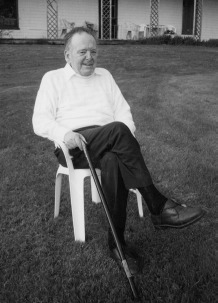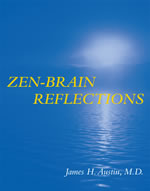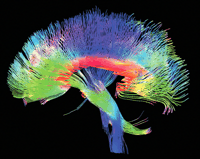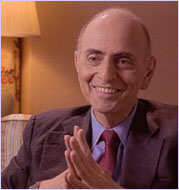 Last week, I proposed 25 research topics for neurotheology . The underlying theme was to find phenomena somehow related to religion—for instance, speaking in tongues occurs in explicitly religious contexts, while some schizophrenics display quasi-religious behavior—and then inquire as to the neural bases of those phenomena.
Last week, I proposed 25 research topics for neurotheology . The underlying theme was to find phenomena somehow related to religion—for instance, speaking in tongues occurs in explicitly religious contexts, while some schizophrenics display quasi-religious behavior—and then inquire as to the neural bases of those phenomena.
There is a single researcher who has addressed many more of these topics than any other: Julian Jaynes (picture; Wikipedia entry).
Jaynes was a psychology professor most noted for his book The Origin of Consciousness in the Breakdown of the Bicameral Mind, where he laid out his astonshing thesis that consciousness is of recent origin (three millennia ago), and replaced internal voices as the basic means of human self-control. These internal voices were what were referred to as gods, and, he claims, the predecessors of the variety of gods people worship today.
Of course, many people think Jaynes is simply a crackpot; see this Salon article by Mark Wallace for an example. But these critics really need to come up with better attacks. For instance, Wallace says that “Jaynes displays a hallmark trait of the crackpot authority in drawing from widely disparate disciplines to back up a hypothesis that would never even occur to most scientists.” That’s supposed to be bad?
The illustrious Daniel Dennett, for one, is a Jaynes fan, and in his article about Jaynes reprinted in Brainchildren ) he provides a highly succinct summary of Jaynes’ hypothesis: that the human brain has gotten a “software upgrade” in recent millennia, while suggesting that many of the details of Jaynes’ theory—even the supposed centerpiece involving auditory hallucinations—are optional.
It is not at all surprising that Jaynes covers nearly half of the issues in my list of 22 research topics for neurotheology: mental illness, brain pathology, hallucinogens, polytheism, hypnosis, music, genetics, speaking in tongues, and at least one I omitted, poetry. Not surprising because Jaynes, in a way, is the original neurotheologist par excellence. In spite of its title, his book is not really about consicousness; indeed, Jaynes spends the entire first chapter making the point that consciousness, appropriately defined, is basically just a tool we humans use to do some things more effectively, but is hardly at the core of our experience.
Instead of consciousness, what the book is really about is God, or god, or gods, how they functioned before the advent of consciousness as we know it today (as verbalized messages from the right brain to the left), and how their vestiges constitute what we think of as religion today. In other words, “Breakdown” is really the “Bible”, so to speak, of neurotheology.
Love Jaynes or hate him, his theory remains, after 30 years, indisputably the single most comprehensive, wide-ranging, imaginative hypothesis available.
Reading this book, I had the uncanny feeling that perhaps our country is slipping back into bicamerality—by which I don’t mean having two houses of Congress, but rather Jaynes’ pre-conscious state. After all, we now have a President who said he was “told” by “God”—a voice, in other words—to invade Iraq, and a country which responded by electing him to another term.
 Zen-Brain Reflections is James H. Austin’s follow-up to his definitive Zen and the Brain. As always, Austin is learned and thorough. The book has great value. It is almost certainly the best survey of research in the field of neurotheology, or perhaps we should use Davidson’s term “contemplative neuroscience.” But ultimately it’s closer to a set of research notes than a book. It presents tantalizing ideas and intriuging possibilities, but few hypotheses or frameworks. We’re left with a lot of information, but little understanding.
Zen-Brain Reflections is James H. Austin’s follow-up to his definitive Zen and the Brain. As always, Austin is learned and thorough. The book has great value. It is almost certainly the best survey of research in the field of neurotheology, or perhaps we should use Davidson’s term “contemplative neuroscience.” But ultimately it’s closer to a set of research notes than a book. It presents tantalizing ideas and intriuging possibilities, but few hypotheses or frameworks. We’re left with a lot of information, but little understanding.
 Do people see God in their dreams? If so, this could contribute to our understanding of how humans view the divine.
Do people see God in their dreams? If so, this could contribute to our understanding of how humans view the divine. Scientific American Mind (
Scientific American Mind ( Do kids naturally believe in an afterlife, or is it something they’re taught?
Do kids naturally believe in an afterlife, or is it something they’re taught?  Last week, I proposed
Last week, I proposed  What is the mechanism by which meditation enhances brain function ? At the
What is the mechanism by which meditation enhances brain function ? At the  Clearly drugs cannot contribute to enlightenment. Right? According to James Austin’s new book, “Zen-Brain Reflections,” which I posted on
Clearly drugs cannot contribute to enlightenment. Right? According to James Austin’s new book, “Zen-Brain Reflections,” which I posted on  Mirror neurons (
Mirror neurons ( I’m having huge fun reading Carl Sagan’s
I’m having huge fun reading Carl Sagan’s  How does the drug ketamine bring on visions of God?
How does the drug ketamine bring on visions of God?